Static site generators are a new phenomenon in web development world. Their popularity increases every day because of the low cost and ease of use. Static site generators help you develop and operate your websites quickly, especially if you don't need much customization.
Static sites have a lot of benefits. They can be published faster, for one. There's no need to worry about pesky content management systems (CMS) bugs and security issues, either. These sites are easy to update and share, and they don’t require any server maintenance. It's also easier to scale static sites than dynamic ones. But which static site generator should you use?
In this article, we'll dive into the most popular static site generators on the market. We'll explore their pros and cons and give you an idea of how they stack up against each other.
If you don't have experience with static site generators, you can start with TeleportHQ, our collaborative low code platform that automatically writes code and deploys, so you don’t have to. If you want to code faster, all you need to do is create your account — it's free, no credit card required!
Now, let's get started to help you decide which static site generator might be best for your needs.
What are popular static site generators?
A static site generator is a website builder that creates a fully-functional website based on content. It is most popular with web designers and web developers.
Unlike dynamic websites built with database content management systems that require constant server maintenance, static site generators don’t need a database. They work by generating the content on your website then pre-rendering it as HTML files.
Once someone visits your blog, they don’t have to wait for anything to load to see your latest post.
Who uses popular static site generators?
Static site generators are an excellent choice for developers. They often choose to use them because they want to avoid worrying about things like databases or server-side programming.
What’s more, they allow designers to have complete control over how the site looks without worrying about things like security or databases. It is also an excellent solution for bloggers who want to create a blog and don’t want the hassle of worrying about technical issues.
The benefits of popular static site generators
Static site generators are excellent for many websites, including blogs and portfolios. The quick setup process and easy deployment are some of the best reasons to use a static site generator. Also, static site generators are highly customizable, making collaboration between designers and developers a breeze.
Now let’s get into some specifics as to why you might want to consider using a static site generator.
Static site generators are fast
Static site generators are fast because they don’t require any database calls, which means they can load pages within milliseconds. It is essential for those with slow internet connections or who want their website to load quickly on mobile devices.
Static site generators are easy to use
Static site generators are simple for designers and developers who want complete control over their site looks without managing a database or server-side programming. They also simplify blogging for bloggers who want to focus on creating good content with little hassle.
Static site generators are cost-efficient
Static sites are cost-efficient because there is no need for a server-side language, which means you can host it anywhere with a web connection, such as your computer or Dropbox account. You don't need an expensive hosting plan either!
Static site generators provide high security
With static sites, you don't have the same risks of getting hacked since there is no database access, leaving your website secure from attacks like SQL injections and XSS bugs.
Not everything is perfect in this world, and neither are static site generators. Before we dive into our ten most popular static site generators for 2022, let’s see what the drawbacks of SSGs are.
The drawbacks of using popular static site generators
There are a few drawbacks of using static site generators. One such drawback is that many of these generators aren't as quick or easy to use compared to other website builders. They require more code and technical know-how to build the website.
Another downside is that it's difficult to find plugins for many static site generators. A plugin is a software extension that adds a specific feature or functionality on top of the core capabilities of the generator. When you're building your website with a static site generator, you won't have access to any plugins since plugins are generally used within other types of websites (like those built with WordPress).
Finally, another drawback to using a static site generator is that there are fewer options for customization when compared to other types of websites like WordPress. You'll likely need some coding knowledge to customize your design, which can be challenging for non-tech savvy users.
What are the most popular static site generators in 2022?
We chose static site generators that have generated the most interest in recent years for this list. Some of these are very simple, and some are more complicated, so this list should give you an idea of what solutions are on the market and help you decide which one is best for your needs.
The first one on the list comes with the fastest learning curve, and you’ll soon understand why.
1. The best static site generator: TeleportHQ

TeleportHQ is an in-browser static site generator that works simultaneously as a hosting service and a collaboration environment. Once your team finishes dragging and dropping page elements, you can host your website without switching a tab or export it to another static site generator. It’s up to you.
Paul Brie built this front-end development platform in 2017 to centralize the whole process of creating websites while leveraging the power of AI to improve data visualization and code generation. It’s an open-source project with 41 repositories on Github.
Who is TeleportHQ for?
TeleportHQ is a static site generator for web designers, web developers, content creators, marketers and business owners with basic or advanced web development skills. If you can’t code, you’re in the right place. If you can code, you’re in the right place.
How to run TeleportHQ
You don’t have to install anything to run TeleportHQ. You just need to make an account. Deploying a TeleportHQ website takes seconds. All you have to do is click publish and choose a publisher.
The most effective deployment would be to TeleportHQ hosting or Vercel. Alternative hosting options include Now, Netlify, GitHub Pages, Zip and Disk.
TeleportHQ features
- Project sharing is available, meaning you can handle teamwork from a single place.
- Free static website templates
- Free hosting available on TeleportHQ and third-party cloud servers
- Export code in 9 javascript frameworks, as well as HTML and CSS
- Reusable components for multiple projects
- Browser-based, React UI builder
- Javascript frameworks export: React, Angular, Next, Vue and Nuxt
- Responsive websites with real-time preview (including templates)
- Advanced customization allows you to fiddle with HTML, CSS and Javascript.
- Technical SEO features that increase loading speed: Gzip, minification, CDN, automatic image compression and conversion into browser-friendly formats.
- You can control the tech SEO aspect of your website.
- It has an MIT license.
- It utilizes machine learning to improve code generation and data visualization.
TeleportHQ integrations
TeleportHQ offers Figma integration to turn high-fidelity prototypes into exportable code.
TeleportHQ customer support
TeleportHQ has an active community on Discord that will be happy to answer your questions or see your project. It is available to all users. Paying users are entitled to dedicated customer support, account manager, and the ability to make custom development requests.
TeleportHQ pricing
TeleportHQ offers three pricing plans – free, professional and enterprise. Each plan includes:
- Free subdomain hosting
- Google fonts
- Interactions and states
- Responsive templates
- Global style guide
- Ability to import custom fonts
- Smart media queries
- Figma import of high-fidelity prototypes
- Code export
Professional plan costs $15/month/editor, and it comes with unlimited projects and view-only collaborations, private projects and dedicated customer support.
Enterprise plan has a custom price and comes with unlimited domains, advanced permissions, custom integrations and more.
TeleportHQ pros
- Build, collaborate and deploy a website from one place without installing a single runtime environment
- One-click code generation and export to various JS frameworks and static site generators
- Figma integration makes it perfect for web designers.
- AI-powered features make it progressively better.
- You’ll soon be able to convert a hand-drawn website idea into code with a wireframe editor.
- The TeleportHQ team is bringing a code-free environment to AR and VR.
- Auto-complete values in the workspace
TeleportHQ cons
- It still can’t be considered a Jamstack.
- Its community on GitHub is not as active as it could be
- Some elements are too tiny in the editor.
2. The most popular static site generators: Publii
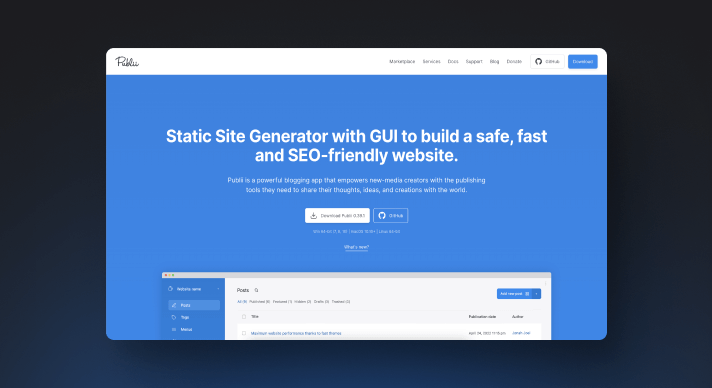
Publii is a free-forever desktop-based static-website CMS aimed at businesses and users that need a simpler tool to create and curate their websites. It was built in 2016 by Tomas Dziuda and Bob Mitro. Their goal was to provide a WordPress and Joomla alternative to focus on static pages and provide features to improve Page Speed Insights results.
Because GitHub is an environment mostly for developers, a static CMS like Publii is doing well with 3.8 stars and 249 forks.
Who is Publii for?
Publii is a good solution for all users who want to run a blog or a simple static website, regardless of their web-development experience. The user interface is intuitive, and there’s enough documentation to get you started, even if you don’t know a single thing about HTML, CSS, JavaScript and similar topics.
However, if you are frontend-savvy, you’ll be able to get more out of this CMS for static websites thanks to the many advanced features it provides.
How to run Publii
Publii is a desktop-based CMS, so it requires installation. The good thing is that it works on all operating systems. As far as deploying it to a server, it’s as simple as clicking the “sync to your website” button. However, you’ll have to configure the server first, which is relatively easy. Here are some deployment options:
- FTPs
- S3 compatible storage
- GitHub Pages
- Netlify
- Google Cloud
- GitLab Pages
- Manual upload
Publii features
- It operates under GNU General Public License 3.0
- Once you install Publii on your computer, free themes are immediately available.
- Installing new themes is straightforward: download the theme, drag and drop the zip file onto the themes section and follow an easy installation process.
- It uses SEO-friendly URLs
- HTML and CSS compression and remove HTML comments are default features
- Basic settings offer the following options: posts per page, tag posts per page, author posts per page, excerpt length, website logo (not included in all themes)
- Custom settings allow you to change widths of the central and sidebar columns using percentages, VW or rem
- For every theme, you can set up the layout, color, fonts, menus, search, share buttons, comments, footer, gallery, and switch the lazy load on or off.
- Post workspace is intuitive and reminiscent of how WordPress works (Gutenberg editor and classic paragraphs spring to mind)
- You can add favicons.
- Easy navigation menu creation, you’ll have to assign it to either the header or the footer.
Publii integrations
Publii is testing out its integration with WordPress so you can migrate your WP articles.
Publii customer support
Publii free support includes a forum, documentation, useful resources and a blog. Premium support is accessible upon any purchase. In addition, there’s also a GitHub community you can reach out to if you get stuck with publishing your blog.
Publii pricing
Even though the software itself and some of the themes are free, using Publii can cost you money if:
- You want a premium theme
- You want web development, customization, migration or other services
Out of the 24 themes, 10 are forever free, and you can get the remaining 14 for a bundle price of €169, including a discount. A single premium theme costs €35.
All premium services are quote-based and include complete website development, customization, migration and assistance with GDPR.
Publii pros
- Easy setup and intuitive interface
- Helpful documentation
- Much better security than regular CMSs because it operates without a server
- Because it works offline with fewer dynamic elements, it makes it more difficult for hackers to access your data.
- New features include a spell checker, multilingual support and an eCommerce option with a 3rd-party eCommerce service.
Publii cons
- Collaboration is possible but not streamlined. You and anyone who’ll collaborate with you will have to have a Dropbox account. Then you’ll have to move your Publii files there and set up Publii to publish on Dropbox.
- Another downside of collaborating through Dropbox is the file-syncing that gets messed up when two different users alter the same file
- Handling newsletters via Mailchimp is a hassle, and it includes coding (it's not a good option for users who don't have coding skills)
3. The most popular static site generators: Gatsby

Gatsby is an open-source react-made static site generator built in 2017 by Kyle Mathews to adapt a framework to the internet users’ current habits.
He noticed that the existing frameworks have operated under the assumption that devices have a reliable connection to the internet. This assumption was the reason for failing to deliver fast websites. In 2017 and especially today, people use the internet on their smartphones connected to 4G networks. That’s not a stable connection.
As Gatsby has had a significant impact on the static site generator community, it doesn’t surprise that it has 52.5K stars and 10.2K forks on GitHub.
Who is Gatsby for?
Developers who know their way around React will relish this static site generator. Companies that expect growth will need to use a static site generator such as Gatsby if they want to expand from a static website into a multi-functional web app with dynamic elements.
Snapchat, Tinder, Payhere and Stack are some of the most popular companies that rely on Gatsby.
How to run Gatsby
You’ll need to install Node.js and some additional features depending on your OS to run Gatsby. For Windows, you’ll need to install Windows Subsystem for Linux (WSL). For Linux, you’ll have to install NPM.
You can deploy Gatsby on its cloud, which is something most static site generators don’t offer. In addition, there are over 20 cloud servers you can deploy a Gatsby website on.
We recommend you give their cloud a go because it gives insights into your site performance, SEO, and architecture that builds sites in under 10 seconds.
Gatsby features
- Uses React.js components to build websites
- Real-time changes on pages, templates and styles
- Uses the PRPL pattern that deploys sites to smartphones on unreliable networks incredibly fast
- It can generate structured data and metadata automatically via the react-helmet component
- Generates HTML, CSS and JS (not every GSS does this)
- It has over 2500 plugins (for Shopify, WordPress, Algolia, Amazon S3 and more)
- It has a Figma plugin to generate code for high-fidelity prototypes
- Collaborating on Gatsby Cloud is possible by using Gatsby’s unique shareable URL
- Inlines critical CSS
- Provides offline access in case your connection is unstable
- Works with serverless hosting (this includes their cloud)
- Displays UI changes without refreshing the page while editing code or content
- Effective image optimization, routing and linking as an extension to the core React library
- Uses Graph QL query language
- Has an MIT license
Gatsby integrations
The integrations list is extensive, and it covers the most popular analytics tools, data sources and various other tools like Emotion, Linaria, PurgeCSS, MaterialUI and more.
Gatsby customer support
Gatsby offers email support to all users. Also, the documentation page is full of tutorials such as how-to, reference and conceptual guides. Enterprise users get Slack support, dedicated account rep, onboarding and migration, hands-on training and a performance audit.
Gatsby pricing
Gatsby offers three plans: free, professional and enterprise. The professional plan costs $42.5/month. You can get the pricing for the enterprise plan upon inquiry.
Each plan comes with:
- The following repo types: GitHub, GitLab, BitBucket
- Unlimited deployments per day and monthly build minutes
- Deploy, PR/merge and CMS previews
- At least 33 points of presence (POPS)
- At least 1M requests
- At least 100k serverless function requests
- Email support
Both professional and enterprise plans come with more users, concurrent builds, custom domains, bandwidth and build memory.
Gatsby pros
- It’s a Jamstack SSG, which increases its usability
- Integrated React.js feature makes it more user friendly
- Suitable for deploying sites to smartphones on unreliable networks
- Easy site migrations
- Helpful API integrations
- Creating a Gatsby cloud account is free
- Creates good SEO automatically (image optimization, code minification, generation of metadata and structured data)
- Code changes are visible in real-time
Gatsby cons
- It will build websites with thousands of pages incredibly slowly
- It only accepts Markdown and JavaScript template files
- Can’t generate HTML, CSS and JS at runtime
- User authentication could be better
- Not all features are free, which is not the case with some other competitors
4. The most popular static site generators: Next.js
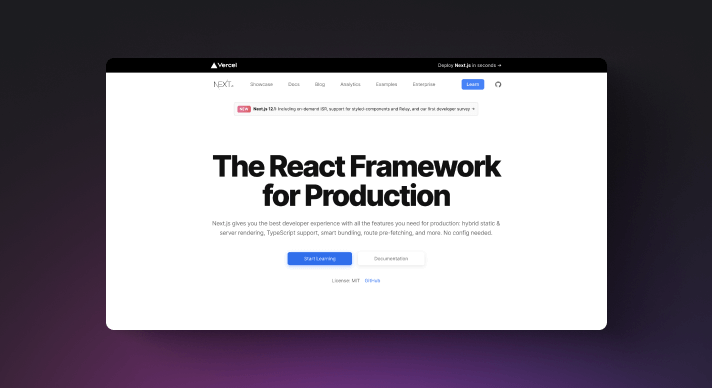
Next.js is a minimalistic Jamstack framework for fast static websites. Guillermo Rauch built it in 2016, using Javascript, Typescript and Rust. Its primary purpose is to build scalable React applications.
It’s got 83.1k stars and 17.3k forks on GitHub.
Who is Next.js for?
React developers that use Vercel will probably enjoy Next.js the most. Also, companies that anticipate growth should consider building their static websites with this SSG.
Since scalability is the Next.js-related buzzword, it doesn’t surprise that giants like Netflix and Starbucks have built their websites with it.
How to run Next.js
Next.js needs the latest version of Node.js to run correctly. Even though you can deploy your static website to a Next.js server, AWS EC2 or Digital Ocean Droplet, it works best when deployed to Vercel, free only for non-commercial sites.
Next.js features
- Next.js optimizes web font loading by default, which significantly improves website score in Lightroom
- Outputs HTML and assets like CSS and JS (other static files too)
- With Next.js, you can pre-render pages at build time, at runtime and you can generate a list of pages that will pre-render at runtime
- You can use it for dynamic websites too
- The Next.js image component has built-in performance optimization features that improve your Core Web Vitals score:
- It always shows images in sizes appropriate for each device
- Automatically prevents cumulative layout shift
- Blurs-up placeholder and loading images only when they enter the viewport On-demand image resizing even on remote servers
- ESLint is a built-in feature
- Supports Typescript
Next.js integrations
Next.js is integrated with Gatsby to migrate your projects from one static site generator to the other. You can handle API routing through GraphQL integration.
Next.js customer support
Because it’s so popular among the developers, finding solutions for your problems is easier, regardless of what developer community you go to. It’s got enough documentation to get you started if you are a newbie.
Next.js pricing
Next.js is free to install and use, as it has an MIT license. Deploying it might cost you if you choose Vercel as your cloud server.
Next.js pros
- Built for scaling
- Built-in SEO features are aligned with the recent Google algorithm updates
- Reusable components
- Uses a CSS parser
- Fast refresh and data fetching
- Built-in ESlint helps you code faster
Next.js cons
- No native themes are available, which slows down your build
- Lacks plugins when compared to its competitors
- Lacks state management features necessary for eCommerce, which hinders its scalability
5. The most popular static site generators: Jekyll
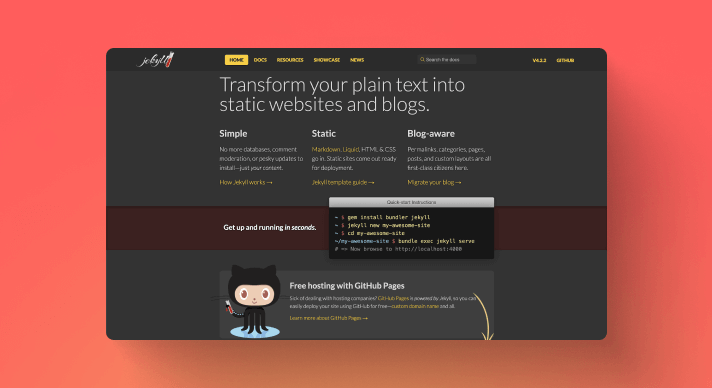
Jekyll is a static site generator created by Tom Preston-Werner, one of the founders of GitHub.
Jekyll is so fitting for generating blog websites because it structures pages by posts, which is a very blog-friendly way to do it. Due to its strong connection to GitHub, you can host your serverless Jekyll websites on GitHub Pages.
This static site generator has 9.7K forks and 44.3K stars for its repositories on GitHub.
Who is Jekyll for?
As with most static site generators on this list, Jekyll is best suited for web developers experienced in Javascript and JS frameworks. Also, if you’d like to customize themes, you’d have to know how to use Liquid (a templating language).
Since it’s a static site generator, owners of blogs, personal projects and organization websites can leverage its many features. Ruby on Rails, Sketch, and Spotify for Developers are some big players that use Jekyll.
How to run Jekyll
- If you want to run it on your local machine, you’d have to install Ruby version 2.5.0 or higher, RubyGems, GCC and Make
- If you plan to work on GitHub, you should set up Git and use Bundler to install and run Jekyll. Using Bundler prevents bugs and manages Ruby gem dependencies well
- As we already said, if you want to customize themes, you’ll need to use Liquid.
Jekyll features
- MIT open-source license
- Free hosting with GitHub pages
- Delivers HTML, CSS and JS
- Handles migration from over 25 CMSs (WordPress, Behance, Blogger, Tumblr, Drupal 6,7 and 8, to name a few). The migration does require some extra steps, but it’s * usually very straightforward. For each importer, you’ll have to install some additional libraries
- It supports both HTML and Markdown
- Supported data files: YAML, JSON, CSV
- There are 1500 public repositories on GitHub, where you can find a theme that fits your needs
- Generates HTML, CSS and JavaScript files from templates, Markdown or Sass files
Jekyll integrations
By utilizing the power of integrations, you can overcome Jekyll shortcomings, like the lack of a graphic user interface.
If you use Jekyll on GitHub, Siteleaf integration will take care of that. If you run your websites on WordPress, you can only use it as an editor and export content into Jekyll using the WordPress2Jekyll plugin.
You can integrate Talkyard as a hassle-free alternative to Disqus that will help you embed comments to a Jekyll website.
There are many other integrations for content management, forms, e-commerce and search to improve your Jekyll experience.
Jekyll customer support
Jekyll is an open-source platform funded through sponsorships and maintained by volunteers. There’s no help desk or a dedicated CS rep. On the other hand, their forum is a very active environment where you’ll get your question answered quickly. They also have extensive documentation to sift through in the meantime.
Jekyll pricing
Jekyll is free to use. What you might pay for are 3rd-party themes, and that’s it. Hosting static websites on GitHub Pages is also free of charge.
Jekyll pros
- It has a built-in server (you can host your website on GitHub)
- You can run it without database access, which increases loading speed, stability and security
- Because all themes are gem-based, updates are streamlined
- Increased stability because it only delivers text files
- Lack of dynamic elements makes a Jekyll website a no-priority target for hackers
- It’s well documented
- It’s very easy to run
- Very active community
Jekyll cons
- There’s no way to optimize images, which reduces its SEO potential
- Sites with a lot of posts will be slower if you build them with Jekyll
- It’s built primarily for Linux and OSX, so setting it up on Windows will require extra effort
- It shows bugs if you have Ruby version 3.0.0 or higher, but it’s fixable
- As is the case with most similar SSGs, it’s not for non-developers
6. The most popular static site generators: Eleventy (11ty)
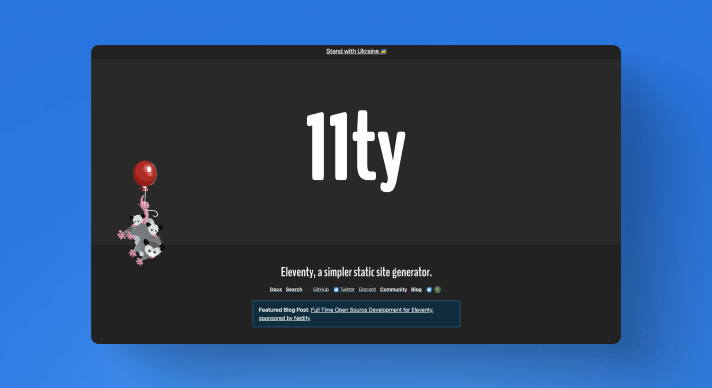
Eleventy is a free Jamstack static site generator that Zach Leatherman built in 2018 using only Javascript. He envisioned it as an alternative to Jekyll. Its strongest points are simplicity and accessibility. Eleventy is an open-source project with an MIT license, like most competitors.
Since it’s a newer repository compared to most other static site generators, 11.6k stars and 354 forks sound about right for a GitHub score.
Who is Eleventy for?
Eleventy is best suited for front-end web developers. Netlify, Web.dev and developer.chrome.com use it. If you’re new to static site generators, it's good to know that it has a fast learning curve to help you get started as soon as possible.
How to run Eleventy
You’d have to install Node.js and the npm command-line interface to run Eleventy. You can choose one of these deploying options to publish your static website on:
- Netlify
- Netlify Drop
- Vercel
- GitHub Pages
- Cloudflare Pages
- GitLab Pages
- Render
- Azure Static Web Apps
- Layer0
- Begin
Eleventy features
- Good choice of templating languages: HTML, Markdown, JavaScript, Liquid, Nunjucks, Handlebars, Mustache, EJS, Haml and Pug
- Excellent for custom shortcodes when you want to use SVG libraries
- It has a FETCH plugin that allows you to save assets to a local cache, meaning you can work even when the network connection fails
- You can install Jest or another testing framework to test your code (Jekyll, 11ty’s competitor, struggles with this aspect)
- Great for blogs because it handles pagination well
- Because it supports computed data, it lets you play with dynamic templating
- It supports remote images
- Great documentation
- You can do incremental builds on 11ty
- Templating is made easy, so you can tweak layouts, collections, pagination, page dates, permalinks or create pages from data
Eleventy integrations
You can integrate Eleventy with Google Analytics, Contentful, GitHub Flat Data, Disqus, Medium and many others. It operates in an open-source environment, so new integrations are arriving as you read.
Eleventy customer support
Eleventy documentation is a great place to start looking for solutions to your problems. There are also blogs and the Discord community to help you out.
Eleventy pros
- It’s fast
- Easy to learn (if you’re a developer)
- You’ll only need Node.js version 12 installed to run it
- You can work on your code on spotty networks that often disconnect, thanks to the FETCH plugin
- Handles pagination well, so it’s good for blogs
- It’s easy to install Jest or another code testing framework
Eleventy cons
- Migrating from WordPress is a bit of a challenge
- It doesn’t have its cloud
- Stumbling blocks will be aplenty at the beginning until you get the hang of it
- Namespacing is not user-friendly, so it isn’t easy to debug it
7. The most popular static site generators: Hexo
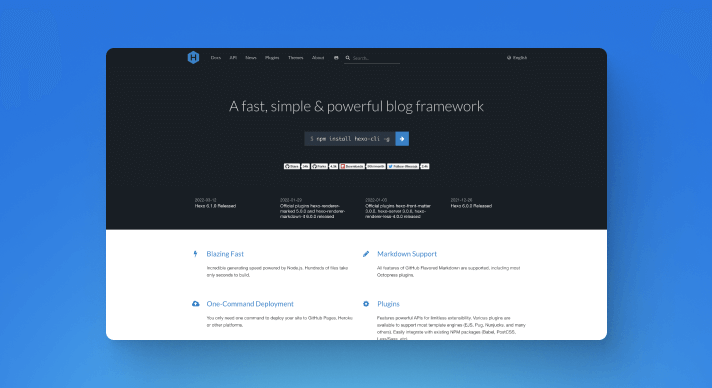
Hexo is a free, simple-to-use Node.js-based static site generator, launched by Tommy Chen in 2021.
It’s got a wealthy theme database (354 at the moment of writing this post), and, like most open-source solutions, it has an MIT license. According to the star and fork count on GitHub, it’s the sixth most popular static site generator (34k+ stars and 4148 forks).
Who is Hexo for?
Web developers that already use Node.js will be more interested in using Hexo than Gatsby or Jekyll, which run on other runtime environments. As usual, you’ll get the best out of it if you have sufficient web development experience. However, their documentation and Youtube tutorials can help a designer with the basic knowledge of web development to use this static site generator.
How to run Hexo
To run Hexo, you’ll have to install it on your local machine, along with Node.js (recommended 12.0 or higher if you want to run the latest version of Hexo) and Git.
Using its one-command deployment, you can deploy a Hexo site on GitHub Pages, Heroku, Netlify or Cloudflare. More deployment options are available in the plugin section below.
Hexo features
- It supports Markdown
- Tag plugins handle rendering more complex pieces of content in Markdown files, including changing colors according to the programming or markup language you use.
- They save you from writing HTML code. As long as you don’t wrap them in Markdown syntax, you’re good.
- You can easily migrate from RSS, Jekyll, Octopress, WordPress and Joomla
- There are three default layouts: post, page and draft
- It supports both YAML and JSON formats for front matter
- Asset folders store static resources related to your blog that you can access on your markdown files, which is very convenient if you handle more content
- Data Files are a simulation of a database, where you can store and access data not related to one specific blog post (also uses YAML ad JSON formats)
- Inserting Open Graph data is streamlined with a built-in feature
- Templates: Nunjucks, EJS, Pug, Haml, Swig, Marko, Mustache, Twig, Handlebars
Hexo integrations
You can integrate Hexo with almost anything and everything through its plugins: Node.js, TypeScript, Heroku, GitHub Pages, Netlify, CoffeeScript, Buddy, GitLab Pages, Azure Search, DatoCMS, Tipe, Front Matter, Cusdis, Deploy Now.
Stay on the lookout if you haven’t found a plugin for your specific need. Its open-source community is publishing new plugins frequently.
Hexo customer support
If you’re facing issues with Hexo, you can get help in the GitHub discussions or some more popular developer communities like StackOverflow or Reddit.
Hexo pricing
Using Hexo is free, and the only thing you could pay for relating to Hexo is server storage.
Hexo pros
- Great Markdown support
- Very fast because of Node.js (builds hundreds of files in seconds)
- It has a vast library of plugins and themes (freebies readily available)
- When you use a theme, writing plain text in Terminal will render Hexo on your website in the build phase. Also, having a Hexo theme makes creating new posts easy.
- Serves sites in different languages, using YAML and JSON formats
Hexo cons
- Compiling issues can happen to Mac users
- SEO contributions are limited only to page loading speed
- The majority of its community is not English-speaking
8. The most popular static site generators: VuePress

When Evan You made VuePress in 2018, his primary objective was to provide a feature that other static site generators didn’t have – the ability to write technical documentation effectively.
Since it is one of the youngest free open-source static site generators on our list, its GitHub score sounds pretty good - 20.1K stars and 4.4K forks.
It runs on Vue.js and has an MIT license, just like any good static site generator should. It generates pages as pre-rendered static HTML, which improves the static websites’ Page Speed Insights score. Not only that, but it serves static content as a full SPA once the page loads.
Who is VuePress for?
VuePress is the static site generator for developers who want to write technical documentation. However, it’s useful for other users. With this static site generator, web developers who readily use the vue.js framework will improve workflow.
Some of the companies that use VuePress are FinTech Consortium, Directus and Code Carrot.
How to run VuePress
To run VuePress, you need to install Node.js and Yarn classic. The latter is optional, but we recommend it to avoid installation snags with npm.
VuePress has a simple architecture:
- It serves configuration files for projects and themes, Markdown files and layout components via plugin API
- The plugin uses dynamic modules in Node.js during the build process to achieve this
- Node.js then serves assets and metadata into the browser, while the plugin API serves client add-ons simultaneously
One of the reasons behind its fast loading speed is that VuePress runs a virtual render for every route (similar to Gatsby).
You can deploy it to cloud servers like GitHub Pages, Netlify, Google Firebase, Surge, Heroku, Vercel and Layer0.
VuePress features
- It comes with two pre-installed plugins:
- @vuepress/plugin-last-updated
- @vuepress/plugin-register-components
- The default theme comes with plugins that will help you show the progress and search bars, use containers and smooth scroll
- It has plugins for standard features, content search, PWA, syntax highlights, and theme development
- Because it runs on vue.js, you can quickly develop custom themes if you’re familiar with the syntax
- Built-in markdown extension
- Default theme supports Algolia search, customizable navbar and sidebar, multi-language support and more
- You can debug your custom themes with Vue DevTools
- Uses Stylus for easier handling of CSS
VuePress integrations
The most popular tools to integrate with VuePress are Google Analytics, Algolia, Panelbear and Crowdin.
VuePress customer support
Like with any open-source, you should first check out the available documentation. Thankfully, VuePress' strong side is precisely that. You can also leverage Vue.js’ forum, Discord chat and Dev community.
VuePress pricing
VuePress is an open-source framework, so it’s free to use. You can deploy a VuePress website on GitHub Pages for free.
VuePress pros
- Minimal setup required
- VuePress files sites are simple – nothing more than Markdown files
- Built-in search
- Excellent default theme features. The default theme comes with plugins that will help you show the progress and search bars, use containers and smooth scroll.
- Free hosting from various cloud services
VuePress cons
- There is no jsdoc parsing. You have to write your MD files
- Only allows server-side render
- It has a limited scope because it’s best suited for document sites
9. The most popular static sites: Gridsome

Gridsome is a free open-source Vue-based static site generator with good speed, built by Tommy and Hans-Jørgen Vedvik. It’s fast because its default settings include features like code splitting, asset optimization, progressive images, and link prefetching. Servers and databases are out of the picture too, which also contributes to speedy deployments. Just like Gatsby, it too is a Jamstack framework.
It does have relatively modest popularity on GitHub – 8.1K stars and 485 forks.
Who is Gridsome for?
Since it's a Vue-based static site generator, developers with modest JavaScript experience would be able to use it. It’s still best suited for someone who’s been in the web development business for a while.
Some of the companies that use Gridsome are überdosis, Mobile Action and Code Carrot.
How to run Gridsome
To run Gridsome, you’ll have to install the latest Node.js (installing Yarn is recommended but not required).
When deploying a Gridsome website, you choose Git-based, deploy from the terminal, with FTP or with Netlify drop.
Cloud servers you can deploy to are: NetlifyAWS, Amplify, Vercel, Amazon S3, GitLab Pages, GitHub Pages, Google Cloud Platform, Surge.sh, 21YunBox and Azure Static Web Apps.
Gridsome features
- It uses the Graph QL query language
- MIT license
- Follows the PRPL pattern
- Migrates content from traditional and headless CMSs
- Loads HTML, CSS and JavaScript files
- Generates static files securely to CDNs or a static web host
- Able to generate dynamic apps too
- Leverages layouts to reuse webpage elements on multiple projects
- Vue router makes it incredibly easy to have components mapped to pages
- Gridsome auto-compresses image previews as the users’ browsers load the image, and once they do, Gridsome replaces the blurry preview with a crisp jpg or png file
- It supports markdown files
- The WordPress plugin sources posts and pages from WordPress easily
Gridsome integrations
Gridsome integrates with various CMSs such as WordPress, Drupal, Contentful and Prismic.io.
Gridsome customer support
The support you can get through the Gridsome website is limited to the Discord community link and documentation. You can also join popular developer communities to debug a static website you built in this Jamstack static site generator.
Gridsome pricing
Gridsome is an MIT-licensed open-source framework that you can install and use free of charge.
Gridsome pros
- Easy file naming handles file-based routing and dynamic routing
- The WordPress plugin sources posts and pages from WordPress easily
- You can now add Vue Components to Markdown files with a Vue Remark plugin (great for documentation and portfolio websites)
- It’s completely free
- The hot-reloading feature makes changes visible in real-time during development
- The starters page on the Gridsome website is full of premade projects to get inspired from
- It can build large sites without the Gatsbyesque lagging
Gridsome cons
- To leverage Gridsome’s image compression, you must know to keep images under the /src folder. If they stay in the /static folder, you can kiss compression goodbye
- It doesn’t have its cloud
10. The most popular static sites: Metalsmith
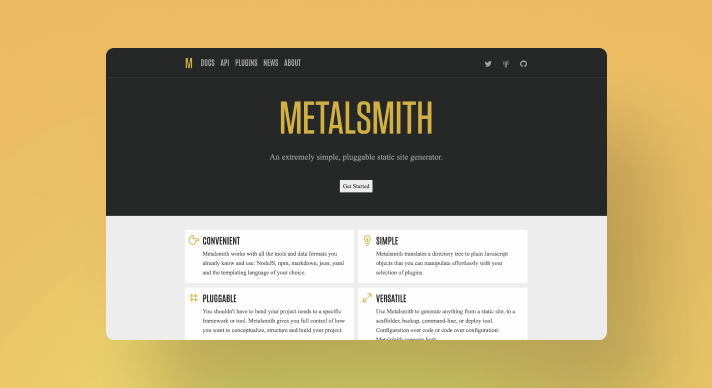
Metalsmith’s inception was in 2014 when Ian Storm Taylor decided to make an alternative to Jekyll. The company struggled with copyright issues and went on a bit of a slope in usage until it finally became an MIT-licensed open-source. That’s why it belongs to the relatively young static site generators club.
Metalsmith has various multi-functional plugins. At the moment of writing, there are 235 registered. It’s adaptable, so you don’t have to depend on one templating language to use it plus, you can quickly expand its role as a static site generator into the world of dynamic websites.
Metalsmith enjoys relatively modest popularity on GitHub with 7.7k stars and 663 forks.
Who is Metalsmith for?
Because it’s a static site generator written in JavaScript, web developers versed in this programming language will make the most use out of it. To fully grasp the hands-free approach of this static site generator, you need to have advanced web development skills.
Some of the companies that use Metalsmith are Drone Deploy, F.biz and World Gaming.
How to run Metalsmith
If you’ve installed node and npm, creating a project folder with a package.json file to install the required dependencies will do the trick. You can also make a node script with an API like Yarn.
Metalsmith features
- User-friendly
- You can use it to build more than static websites if you choose to (it’s a really good document generator)
- All plugins are reusable
- Reads template files from a directory
- Allows file parsing to template placeholders
- Able to use multiple templating languages to render files
- You can host Metalsmith websites on GitHub Pages and Netlify for free
- It provides an underlying logic for the plugin-powered manipulation of a code that’s around 400 lines long
Metalsmith integrations
As far as integrations are concerned, Metalsmith versatile plugins make it integrable with almost any SaaS on the web.
Metalsmith customer support
The team behind Metalsmith has admitted that their documentation could be better, so support isn’t their strongest point, but it’s getting better. They’ve got an active community on Gitter and have recently created a Slack group to increase their support efforts.
Metalsmith pricing
Metalsmith is free to use and it provides an MIT license.
Metalsmith pros
- Multi-purpose plugins
- Metalsmith can render files with a templating engine, convert markdown to HTML, PDF, ePUB, MOBI formats, convert Sass to CSS, minify CSS, compress images, write files to a public directory, build a table of contents and navigation from a tree
- Doesn’t need a back-end environment because it only outputs static files
Metalsmith cons
- To leverage its features, you have to be an experienced developer
- Overall support is a bit lacking, even though the company is working hard to mitigate this
- The documentation needs improvement
The most popular static site generators in 2022: An overview
Based on the benefits, drawbacks, and opinions of both developers and non-developers, here is a short overview of the essential details for each static site generator on our list.
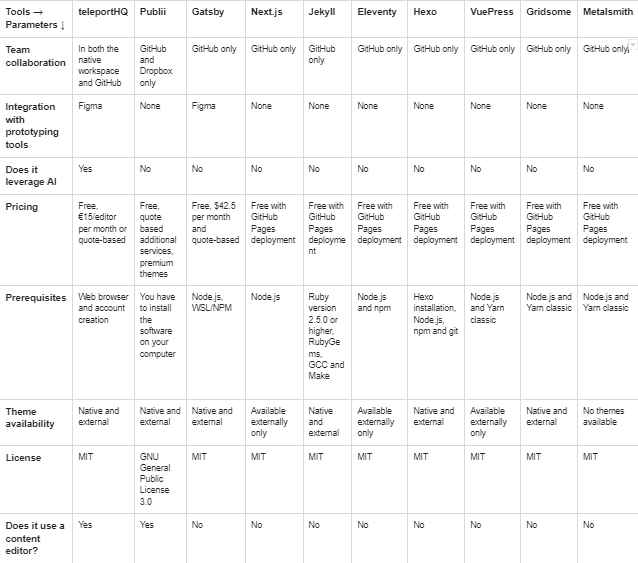
The most popular static site generators: Our verdict
You made it to the checkered flag! The static site generator race is over! And just like in an F1 race, the fine margins separate these tools. Each static site generator is built to facilitate the way we use the internet today, and each is a more efficient alternative to the database-dependent CMSs. However, not all tools can fit your needs.
We believe that our AI-powered tool TeleportHQ fits all users – the visual ones with little-to-no coding experience, those with a yellow belt in the frontend, and those who eat Javascript for breakfast.
Finally, since collaborating on code has never been more important, we believe you’ll leverage our collab features for your projects, whether they’re private or public. Get started today and enjoy all benefits that TeleportHQ provides. It's free, no credit card required.
FAQ
Here is the list of frequently asked questions about popular static site generators.
What is the most popular static site generator?
According to Jamstack.org, the most popular static site generator at the moment of writing was Next.js, with 83,082 stars and 16,905 forks on GitHub. Other popular static site generators include teleportHQ, Gatsby, Jekyll and Hexo.
What is best for a static website?
The best practice for a static website is deploying it to avoid database communication. That way, it will load faster and remain protected from cyber attacks. You’ll have to build your website with a static site generator to achieve this.
What is a static site generator?
A static site generator is a tool that web designers and web developers use to build fast, safe and easy-to-maintain websites. Static site generators deploy static HTML files to cloud servers and don't need a database. Websites created with a static site generator have a high score on Page Speed Insights. It aligns perfectly with the Google algorithm updates that value loading speeds more than ever.
Some static site generators come with content editing software, and some don’t. Most depend on Node.js and a specific Javascript framework to work. Static site generators are usually open-source projects.




